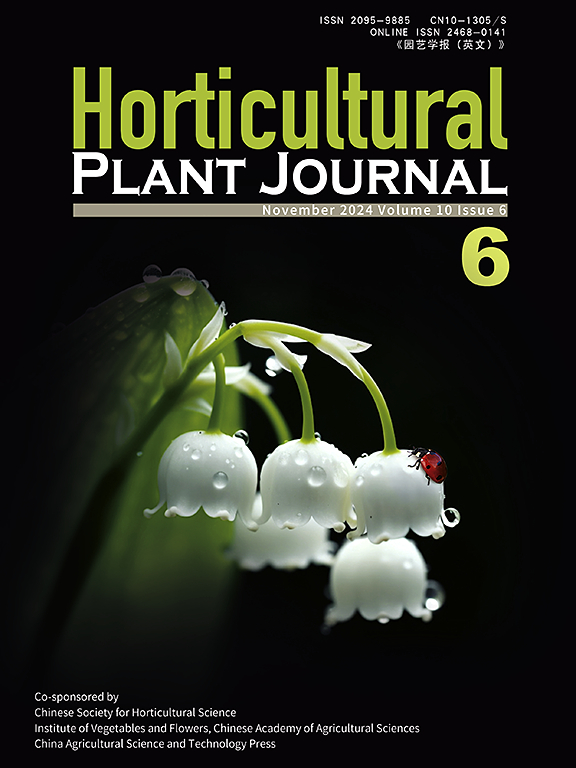Optimal combination of substrate supply amount coupled with nutrient solution management program for cucumber planting
IF 6.2
1区 农林科学
Q1 HORTICULTURE
引用次数: 0
Abstract
Substrate and nutrient supply are essential for vegetable cultivation in greenhouse. The strategies for plant nutrient supply vary depending on the cultivation methods or substrate dosages employed. With the development of mechanization, wide-row spacing substrate cultivation became an optimize mode of the greenhouse cucumber cultivation, aligning with the trend of intelligent agriculture. To determine the optimal nutrient solution supply amount (NS) and supply frequency (SF) for promoting the integrated growth of cucumber under wide-row spacing substrate cultivation, we explored the effects of substrate supply amount (SS), NS, and SF on cucumber yield, quality, and element utilization efficiency. A five-level quadratic orthogonal rotation combination design with three experimental factors (NS, SF, and SS) was implemented for 23 coupling treatments over three growing seasons, including spring (2022S and 2023S) and autumn (2022A). The technique for order preference by similarity to ideal solution (TOPSIS) combining weights based on game theory was applied to construct cucumber comprehensive growth evaluation model. Single and two experimental factors analyses revealed significant effects of single factors and the coupling of NS−SS, NS−SF and SS−SF on the integrated growth of cucumber for all three growing seasons. For the NS−SF−SS combination, the optimal parameters for comprehensive cucumber growth were determined as follows: levels of −1.68 for NS, −0.7 for SF, and −1.682 for SS in 2022A; −0.43 for NS, −0.06 for SF, and 0.34 for SS in 2022S; 0.3 for NS, −0.02 for SF, and 0.04 for SS in 2023S. Furthermore, for SS ranges of 2.00–3.01, 3.01–4.50, 4.50–5.99, 5.99–7.00 (L · plant黄瓜栽培基质用量与营养液管理方案的最优组合
在温室蔬菜栽培中,基质和养分供应是至关重要的。植物养分供应的策略取决于所采用的栽培方法或基质剂量。随着机械化的发展,宽行距基质栽培成为温室黄瓜栽培的优化模式,顺应了智能化农业的发展趋势。为确定促进宽行距基质栽培下黄瓜综合生长的最佳营养液供应量(NS)和供应频率(SF),探讨了基质供应量(SS)、NS和SF对黄瓜产量、品质和元素利用效率的影响。采用3个试验因子(NS、SF和SS)的5水平二次正交旋转组合设计,在春季(2022S和2023S)和秋季(2022A) 3个生长季节进行23个耦合处理。采用基于博弈论的TOPSIS (order preference by similarity by ideal solution)组合权重法构建黄瓜综合生长评价模型。单因素和双因素试验分析表明,单因素和NS - SS、NS - SF和SS - SF的耦合对黄瓜3个生长季节的综合生长均有显著影响。以NS - SF - SS组合为例,在2022A条件下,NS - 1.68、SF - 0.7、SS - 1.682为黄瓜综合生长的最佳水平;2022S中,NS为- 0.43,SF为- 0.06,SS为0.34;2023S NS为0.3,SF为−0.02,SS为0.04。在SS为2.00-3.01、3.01-4.50、4.50-5.99、5.99-7.00 (L·株−1)范围内,春季黄瓜综合生长最大化的NS和SF区间分别为:0.28-0.30 (L·株−1)和6(次·d−1)、0.26-0.30 (L·株−1)和6(次·d−1)、0.25-0.30 (L·株−1)和0.23-0.30 (L·株−1)和6(次·d−1)。在相同SS条件下,秋季黄瓜综合生长最大的NS和SF间隔分别为:0.10 (L·株−1)和8(次·d−1)、0.18 (L·株−1)和7(次·d−1)、0.30 (L·株−1)和6(次·d−1)、0.49 (L·株−1)和5(次·d−1)。研究结果为溶液管理和黄瓜栽培的进一步深入研究提供了理论依据。
本文章由计算机程序翻译,如有差异,请以英文原文为准。
求助全文
约1分钟内获得全文
求助全文
来源期刊

Horticultural Plant Journal
Environmental Science-Ecology
CiteScore
9.60
自引率
14.00%
发文量
293
审稿时长
33 weeks
期刊介绍:
Horticultural Plant Journal (HPJ) is an OPEN ACCESS international journal. HPJ publishes research related to all horticultural plants, including fruits, vegetables, ornamental plants, tea plants, and medicinal plants, etc. The journal covers all aspects of horticultural crop sciences, including germplasm resources, genetics and breeding, tillage and cultivation, physiology and biochemistry, ecology, genomics, biotechnology, plant protection, postharvest processing, etc. Article types include Original research papers, Reviews, and Short communications.
 求助内容:
求助内容: 应助结果提醒方式:
应助结果提醒方式:


